Spring manufacturing is an important part of many industries, and the choice of materials used plays a big role in the outcome. Many people may be surprised to learn that steel is often used over copper when it comes to making springs. But why? Let’s take a look at the benefits of using steel over copper and why it makes for the ideal material for spring manufacturing.
Why is a spring made of steel instead of copper? because Steel has a higher Young’s Modulus, which means it can be made thinner with greater tension levels. This allows us to create small, lightweight springs that are often used in applications where space is limited, such as timepieces or toys. On the other hand, copper has a low Young’s Modulus and needs to be thicker around the same load level, making its use generally more cumbersome. Moreover, steel is less expensive than copper and more widely available for commercial use. All in all, these unique characteristics make steel the optimal choice for use in springs.
Durability
One of the main benefits of using steel instead of copper for spring manufacturing is that steel is much more durable than copper. Steel has higher tensile strength, which means that it can withstand more pressure without breaking or wearing down. This is especially important when it comes to applications like shock absorption and vibration dampening, where springs are subjected to high levels of stress. Additionally, steel springs can last much longer than their copper counterparts, which reduces maintenance costs over time.
Cost-Effectiveness
Steel is also much cheaper than copper, making it a cost-effective option for many businesses. When you factor in the long-term cost savings associated with its durability, steel becomes an even more attractive option as its cost savings compound over time. It also makes sense economically since steel is widely available and easy to obtain in large quantities. This allows companies to produce large volumes at a lower cost per unit compared with other materials, such as copper or aluminum.
Performance
Lastly, steel offers superior performance compared with copper when used for spring manufacturing applications. This includes better corrosion resistance due to its higher chromium content, good flexibility and elasticity under tension, and improved fatigue resistance due to its ability to retain its shape after repeated use. All these factors make steel the ideal material for applications that require springs with high load capacity or shock absorption capabilities.
Conclusion:
In conclusion, there are several reasons why using steel instead of copper makes sense from both an economic and performance standpoint when it comes to spring manufacturing. Steel is cheaper than copper, offers superior durability and fatigue resistance, and provides excellent corrosion protection—all qualities that make it a superior choice for many applications requiring springs with high load capacity or shock absorption capabilities. For website owners and SEO newbies interested in learning more about spring manufacturing materials, understanding why steel can be so beneficial can help them make informed decisions about which material will best meet their needs going forward.

Pipingmart is a B2B portal that specializes in metal, industrial and piping items. Additionally, we share the latest information and information about materials, products and various types of grades to assist businesses that are involved in this business.




